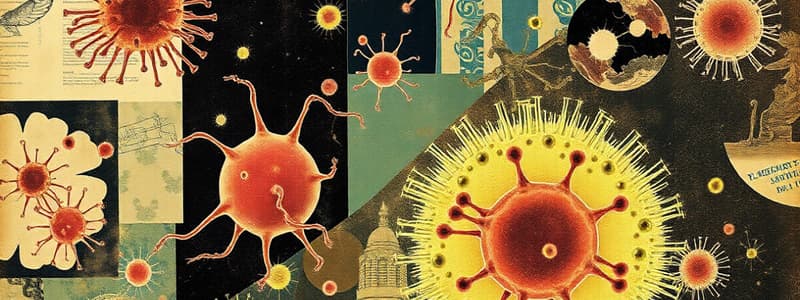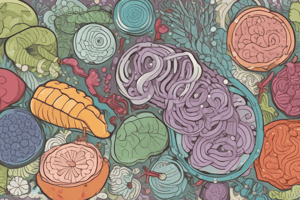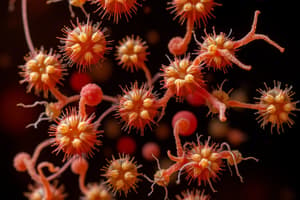Podcast
Questions and Answers
What major advancement in microbiology occurred in the late 19th century?
What major advancement in microbiology occurred in the late 19th century?
- Improvement of staining techniques and microscopy (correct)
- Discovery of penicillin
- Introduction of antiseptic surgery
- Development of vaccines against viral diseases
Which scientist is known for creating Koch's Postulates?
Which scientist is known for creating Koch's Postulates?
- Alexander Fleming
- Louis Pasteur
- Edward Jenner
- Robert Koch (correct)
Which of the following contributions helped disprove the theory of spontaneous generation?
Which of the following contributions helped disprove the theory of spontaneous generation?
- Advances in microscopy and sterilization (correct)
- Discovery of eubacteria
- Development of vaccination principles
- Introduction of antiseptic practices
What role did Edward Jenner play in the field of microbiology?
What role did Edward Jenner play in the field of microbiology?
Which group of prokaryotic organisms includes those of medical importance?
Which group of prokaryotic organisms includes those of medical importance?
What role do most microorganisms play in relation to humans?
What role do most microorganisms play in relation to humans?
Who is considered the 'Father of Microbiology'?
Who is considered the 'Father of Microbiology'?
What happens once a microorganism colonizes the body?
What happens once a microorganism colonizes the body?
What significant contribution did Robert Hooke make to microbiology?
What significant contribution did Robert Hooke make to microbiology?
Which process is essential for maintaining ecosystems as described in the overview of microbiology?
Which process is essential for maintaining ecosystems as described in the overview of microbiology?
What enables the observation of microorganisms for the first time?
What enables the observation of microorganisms for the first time?
Which of the following organisms are studied in microbiology?
Which of the following organisms are studied in microbiology?
What potential outcomes follow the colonization of a microorganism in the body?
What potential outcomes follow the colonization of a microorganism in the body?
What characteristic differentiates prokaryotic DNA from eukaryotic DNA?
What characteristic differentiates prokaryotic DNA from eukaryotic DNA?
Which of the following is true regarding the ribosomes in prokaryotic and eukaryotic cells?
Which of the following is true regarding the ribosomes in prokaryotic and eukaryotic cells?
How do prokaryotic cells typically reproduce?
How do prokaryotic cells typically reproduce?
Which statement accurately contrasts the chromosomal structure of prokaryotes and eukaryotes?
Which statement accurately contrasts the chromosomal structure of prokaryotes and eukaryotes?
What is a key feature of atypical bacteria such as Mycoplasma?
What is a key feature of atypical bacteria such as Mycoplasma?
Which of the following is NOT a common structure found in eukaryotic cells?
Which of the following is NOT a common structure found in eukaryotic cells?
What describes the cell wall of typical bacteria?
What describes the cell wall of typical bacteria?
What type of organisms are classified as fungi?
What type of organisms are classified as fungi?
What distinguishes protozoa from helminths?
What distinguishes protozoa from helminths?
Which of the following correctly identifies a group of helminths?
Which of the following correctly identifies a group of helminths?
How do protozoa primarily transmit infections?
How do protozoa primarily transmit infections?
What is a characteristic feature of viruses?
What is a characteristic feature of viruses?
Which option correctly represents a method of nutrient acquisition for helminths?
Which option correctly represents a method of nutrient acquisition for helminths?
What is the term for single-celled, non-photosynthetic eukaryotic organisms that can be parasites?
What is the term for single-celled, non-photosynthetic eukaryotic organisms that can be parasites?
Which of the following types of protozoa causes malaria?
Which of the following types of protozoa causes malaria?
Which structure is not part of a virus?
Which structure is not part of a virus?
Flashcards
Germ Theory
Germ Theory
The idea that specific microorganisms cause diseases.
Koch's Postulates
Koch's Postulates
A set of rules to prove a specific microbe causes a specific disease.
Prokaryotes
Prokaryotes
Single-celled organisms without a nucleus or other membrane-bound organelles.
Eubacteria
Eubacteria
Signup and view all the flashcards
Pasteurization
Pasteurization
Signup and view all the flashcards
Microbiology definition
Microbiology definition
Signup and view all the flashcards
Microorganism's role
Microorganism's role
Signup and view all the flashcards
Pathogenic microorganism
Pathogenic microorganism
Signup and view all the flashcards
Normal flora
Normal flora
Signup and view all the flashcards
Microbial infection
Microbial infection
Signup and view all the flashcards
Infectious disease
Infectious disease
Signup and view all the flashcards
Anton van Leeuwenhoek's contribution
Anton van Leeuwenhoek's contribution
Signup and view all the flashcards
Robert Hooke's contribution
Robert Hooke's contribution
Signup and view all the flashcards
Prokaryotic Cell Size
Prokaryotic Cell Size
Signup and view all the flashcards
Eukaryotic Chromosomes
Eukaryotic Chromosomes
Signup and view all the flashcards
Prokaryotic DNA
Prokaryotic DNA
Signup and view all the flashcards
Fungi Reproduction
Fungi Reproduction
Signup and view all the flashcards
Bacterial Cell Walls
Bacterial Cell Walls
Signup and view all the flashcards
Atypical Bacteria
Atypical Bacteria
Signup and view all the flashcards
Fungi Characteristics
Fungi Characteristics
Signup and view all the flashcards
Bacterial Division
Bacterial Division
Signup and view all the flashcards
Protozoa Characteristics
Protozoa Characteristics
Signup and view all the flashcards
Helminths
Helminths
Signup and view all the flashcards
Viral Structure
Viral Structure
Signup and view all the flashcards
Viral Replication
Viral Replication
Signup and view all the flashcards
Protozoa Transmission
Protozoa Transmission
Signup and view all the flashcards
Helminths Classification
Helminths Classification
Signup and view all the flashcards
Viral Infection Outcomes
Viral Infection Outcomes
Signup and view all the flashcards
Virus Types
Virus Types
Signup and view all the flashcards
Study Notes
Microbiology Lecture 1
- Microbiology is the study of microorganisms, including bacteria, viruses, fungi, protozoa, and algae.
- Microorganisms are essential for life on Earth, playing roles in decomposition, nutrient recycling, and maintaining human health.
- Some microbes are pathogenic (disease-causing), while others are beneficial, particularly in medicine, biotechnology, and pharmacy.
- Microorganisms exist in every ecosystem and are associated with all multicellular organisms, including humans.
- Many microorganisms are part of the normal flora (bacteria), most are harmless or helpful. Some cause diseases. These are called pathogens.
- Infectious diseases begin when microorganisms colonize the body (skin or mucous membranes) or are introduced into the bloodstream or internal organs.
- An infected organism may have its immune system eliminate the microbes or the microbes may multiply and cause infection and damage to tissue.
- The discovery of microorganisms was possible due to the invention of the microscope. Anton van Leeuwenhoek and Robert Hooke were key figures in microscopy.
- Subsequent advancements in the 17th century allowed for larger magnification by microscopes.
- The germ theory was developed and helped to reject the theory of spontaneous generation, which states that life can arise from non-living matter. Important figures are Louis Pasteur and Robert Koch.
- Modern microbiology emerged in the late 19th century and was influenced by improvements in staining techniques, sterilization, microscopy. Key figures include Joseph Lister and Alexander Fleming. Lister was influential in antiseptic surgery. Fleming developed penicillin.
- Prokaryotic organisms are bacteria, while eukaryotic organisms include fungi, protozoa, and helminths (e.g., humans),
- Prokaryotic and eukaryotic organisms differ structurally.
- Bacteria, archaea, and cyanobacteria are prokaryotic.
- Typical bacteria have shapes such as rods, spheres, and corkscrews.
- Atypical bacteria include mycoplasma, chlamydia, and rickettsia, which differ from typical bacteria in significant structural components or metabolic capabilities.
- Fungi are non-photosynthetic, eukaryotic organisms. Many are filamentous (molds) or unicellular (yeasts). They reproduce asexually, sexually, or both. Fungi cause a range of diseases from skin infections to systemic infections.
- Protozoa are single-celled, non-photosynthetic, eukaryotic organisms with various shapes and sizes. Many are free-living; others are significant parasites. Transmission occurs by ingestion or insect bites.
- Helminths are multicellular, eukaryotic organisms categorized as tapeworms, flukes, and roundworms. They are parasites that ingest/absorb body fluids or tissues to obtain nutrients. They cause diseases in humans.
- Viruses are obligate intracellular parasites,meaning they cannot reproduce outside a host cell. They consist of DNA or RNA molecules coated in protein, and they may have an envelope. Viruses cause many diseases.
Studying That Suits You
Use AI to generate personalized quizzes and flashcards to suit your learning preferences.



